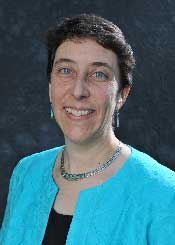
Marty Jacobs ’82 led the May 17th session entitled “Turning Dreams into Reality: The Power of Strategic Planning and Systems Thinking.” Jacobs, president of Systems In Sync, has been teaching and consulting for almost twenty years, applying a systems thinking approach to organizations. She currently provides strategic planning and Policy Governance expertise for the Vermont School Boards Association and has worked with several school districts to engage them in community conversations. The session began with Jacobs telling the participants what your biggest fear a consultant should be: you make a whole and what you feel to be a complete plan, but then see as it “gathers into cob webs.” To show us what this meant, Jacobs gave each small group a balloon and told us to blow it up and not let it fall on the ground. “It seemed like a simple enough task, we just stood in a circle and took turns,” said Maxwell Sloan ’13. However, Jacobs changed the game by adding in another balloon, which unbeknownst to the groups at the time contained a marble that caused the balloon to sink quickly. “We had to react quickly and change our plan for keeping the balloons afloat,” said Joshua Lee ’13.
The groups then came back together and discussed what happened with the balloons. Using the balloon activity as a jumping off point, Jacobs introduced the group to systems thinking, which is the study and use of structure and behavior. To master a task, one must understand interrelationships of organizational systems and realize that it is a process and not a single event. By learning over time, one can look for trends and patterns, and use these lessons to adapt while still completing a task. Jacobs then introduced us to the main concepts for strategic planning: Mission, Vision, and Values. The “Mission” is the organization’s purpose. The “Vision” is the picture of the future the organization seeks to create. The “Values” are the guiding principles that the group uses to complete tasks. To maximize efficiency with these concepts, Jacobs introduced the participants to two methods of analysis: the force field model and the SWOT memo. A force field memo allows a group to assess the current reality compared to the desired outcome. Next, the group must fill in the space in between the two with propelling forces, which send you forward towards the desired outcome, and hindering forces, which set you back. The SWOT memo allows for organizational assessment by forcing the group to clearly layout the Strengths, Weaknesses, Opportunities, and Threats, or SWOT. Jacobs then gave each of the groups a series of different forms of systems thinking from different real-life organizations. The groups looked through the memos and Jacobs asked what the best memos had to offer. Many agreed that beyond the actual content, how an organization presents information is half the battle.
The participants then split up into the small groups to come up with their own organizational plans for hypothetical events using systems thinking. Once the small groups came back together after a half-hour of planning, we realized that a few of the groups created potential events/organizational plans for MLDP. Jacobs moderated a discussion between the groups about how to best advertise the MLDP program, which gave great ideas to the students currently working on attracting students to the program for next year.
Jacobs, after bringing the session full-circle by re-connecting what the participants learned with the initial balloon activity, concluded the program by thanking the participants for their work and interest during the session.
-- Sam Lewis '13
